Global fertilizer markets are showing renewed signs of pressure this week as potash prices edge lower across key U.S. hubs. According to 101.5 WKKG’s Weekly Fertilizer Price Report, potash prices in New Orleans slipped 1.5 %, while Midwest regional prices dipped 0.7 %, reflecting weakening affordability and subdued demand across the agricultural sector.
For investors tracking the potash industry, these declines signal a challenging environment where macroeconomic headwinds and reduced farm input spending are beginning to bite.
Soft Demand Weighs on Fertilizer Inputs
After a strong rally in 2022–2023, global fertilizer markets have cooled significantly amid falling grain prices, easing supply chain disruptions, and shifting crop economics. Farmers across North America have been holding off on bulk fertilizer purchases in hopes of lower input costs later in the year, pressuring near-term potash demand.
Data from Green Markets (Bloomberg) and the U.S. Department of Agriculture (USDA) show that fertilizer affordability has deteriorated relative to corn and soybean prices—key crops that determine input consumption. Potash, a critical source of potassium for plant growth, has been hit particularly hard as planting activity slows and global inventories normalize after last year’s restocking wave.
At New Orleans (NOLA)—a benchmark hub for U.S. fertilizer imports and distribution—average potash prices fell to around US $485 per tonne, while Midwest terminals reported levels closer to US $495 per tonne, according to WKKG/Hoosier Ag Today data published October 21, 2025.
Market Context: From Boom to Balance
The potash market has undergone a dramatic shift in the past two years. Following Russia’s invasion of Ukraine in 2022 and subsequent sanctions on Belarusian and Russian suppliers, prices surged to record highs above US $1,200 per tonne. However, with trade flows gradually rerouted through alternative suppliers such as Canada’s Nutrien Ltd. (NYSE: NTR) and Mosaic Co. (NYSE: MOS), global supply has stabilized, leading to the current correction.
“While supply remains structurally tight, near-term demand destruction has created a buyer’s market,” said Rabobank’s 2025 Fertilizer Outlook, noting that affordability constraints will likely limit upside through the next planting season.
At the same time, Brazil, India, and China—three of the world’s largest potash importers—have slowed tender activity in recent months, signaling a cautious approach amid volatile commodity prices and tighter agricultural margins.
Why This Matters for Investors
For investors, the latest data underscores how cyclical and price-sensitive the fertilizer sector remains. Potash producers with high operating leverage or limited diversification may face earnings compression in the near term, while companies with low-cost operations and flexible sales channels are better positioned to ride out the downturn.
According to Morningstar analysts, global fertilizer equities have underperformed broader commodities by nearly 12 % year-to-date, reflecting the market’s focus on declining margins and uncertain demand recovery. “The ability to manage costs and maintain dividends through price troughs will separate quality operators from the rest,” the report said.
Producers such as Nutrien, Mosaic, and K+S AG (ETR: SDF) have all adjusted guidance in recent quarters to reflect softer pricing and cautious farmer sentiment. Nutrien, for example, reduced potash production guidance earlier in the year by nearly 500,000 tonnes, citing “temporary demand weakness” but maintained confidence in long-term fundamentals.
Future Trends to Watch
- Agricultural Input Affordability:
The relationship between crop prices and fertilizer costs will remain the primary driver of demand. A recovery in grain futures or supportive weather trends could help stabilize fertilizer usage. - Supply-Side Adjustments:
Producers may curtail output or delay expansion projects if prices remain under pressure through Q4 2025. Watch for updates from Nutrien and Mosaic’s upcoming quarterly reports. - Emerging Market Demand:
While North American demand is weak, long-term structural growth in India and Africa could underpin global potash consumption by the late 2020s. - Sustainability and ESG Pressure:
As agricultural sustainability gains focus, companies investing in “smart nutrient management” technologies or low-emission production could gain investor preference.
Key Investment Insight
The current price softness in potash is a reminder of the cyclical nature of the fertilizer industry. For value-oriented investors, the correction phase may offer selective entry points—particularly among producers with robust balance sheets, efficient logistics, and diversified exposure beyond North America.
While short-term weakness may persist through early 2026, long-term fundamentals tied to global food security, soil health, and population growth continue to support the strategic case for potash. Investors should remain attentive to production guidance from major players and monitor signals of demand recovery from developing markets.
Global agricultural commodities often move in cycles—but disciplined producers tend to outperform over time. For ongoing coverage of potash markets, fertilizer trends, and global mining equities, stay connected with explorationstocks.com—your trusted source for investor insights across critical and commodity sectors.






